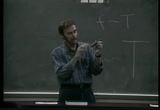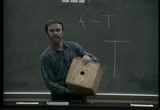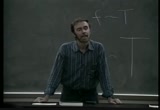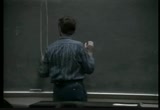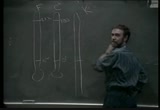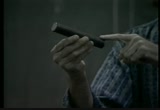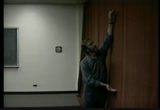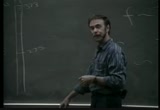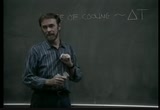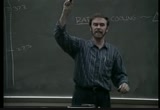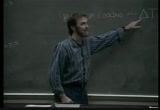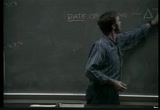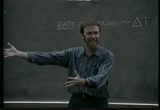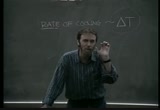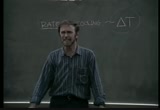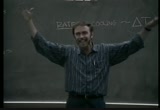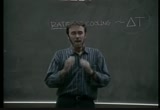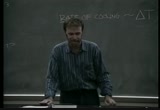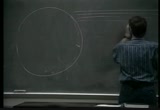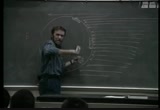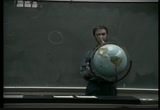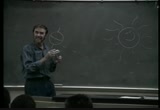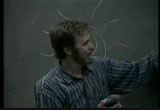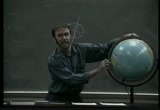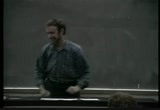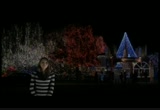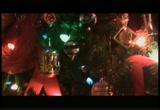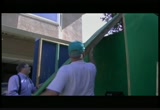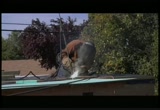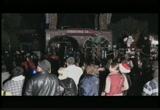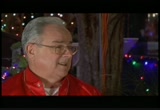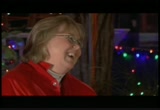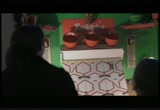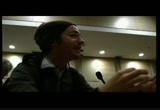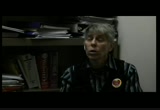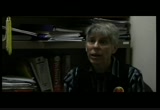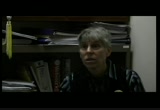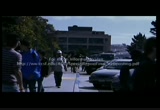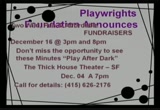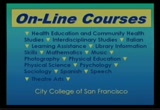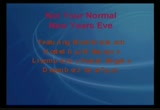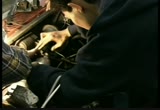tv Democracy Now LINKTV December 11, 2012 8:00am-9:00am PST
8:01 am
okay, gang. let's begin. we were talking about radiation, heat transfer by radiation. we've got heat transfer by conduction, heat transfer by convection and, last of all, heat transfer by radiation. and heat transfer by radiation, we talked about this idea. that everything is emitting radiation of some frequency. these are electromagnetic waves. we'll be talking about electromagnetic waves later in the course. and electromagnetic waves have a frequency. there's a high frequency. tick, tick, tick, tick, tick, tick, tick. and there's a low frequency. tick, tick, tick, tick. there's a vibrational frequency to waves. and that vibrational frequency to the waves is directly proportional to the temperature. temperature of the sun is enormous, and therefore we have an enormous frequency, so high a frequency
8:02 am
that it activates the optical system in your eyes, we call it light. that's very, very high frequency. millions of billions of cycles per second of such little vibrations. very, very high frequency. high frequency because the sun's electrons are shaking at high rates. we'll gonna learn later on, if you take an electron and shake it back and forth, you'll get a wave in space that will shake back and forth at the very same frequency. so it stands for a reason, something of a high temperature with a lot of molecular motion, okay, a lot of charges moving, moving, moving, that that high temperature would give you a high frequency. so this is not counterintuitive. sometimes, we learn things that are kinda a little bit against common sense. we have to look a little deeper till we find out, "hey, it fits after all." this one, we don't. it makes sense that a high temperature would emit a high frequency. if you take a piece of metal, you guys can all see this. you're seeing this piece of metal because light is being reflected from the metal and go to your eyes. but if i turned all the lights out, you wouldn't be able to see this metal.
8:03 am
but what i could do is i could start to heat it, maybe i could pass an electric current through it. and i could heat it, heat it, heat it, and pretty soon it would start to glow. and what color will the glow first, gang? red. it will turn red, and then kinda red orange, yellow, and then it will smear out to a white. it will become white hot. and that would-- and that means what? the temperature is high, high enough so the radiation it's emitting can be seen. see, this is emitting radiation right now. but the temperature is so slow, the temperature of iron is so low compared to that for incandescent, it's over a thousand degrees. the temperature of iron is so low that the radiation that's coming out doesn't activate your sense of sight at all. what you're seeing is reflected light from these hot lamps above but not the light coming from here. but everything is emitting radiation. question? how fast does this radiation travel? all this radiation travels at 300,000 kilometers per second. that's the speed of light. we know light travels that fast. it turns out that the heat rays, so called heat rays, all electromagnetic radiation, 186,000 miles per second
8:04 am
or 300,000 kilometers per second, speed of light. and that's how fast these radiations travel. everything is emitting, and everything is absorbing. if something absorbs, all it kept catches, then it reflects none. i'll show you an idea right here. there's a hole there. is this hole absorbing the radiation that hits it or is it emitting? it absorbs. i've got the color-- i've got the inside of this box painted, gang. and guess what color it's painted? white. black. what color does it look like now? black. white. you've been reading the book, right? [laughter] and we find out, lo and behold, it's white inside. isn't that nice? okay. but when i close the box, boom. look into your neighbor's eyes right in the very, very center, do that right now. how many are shy? [laughter] they said, "no, i don't want to look in the eye." come on, right in the eye. come on. right in the middle. right in the middle.
8:05 am
how many are going like this? haah. that's nice, isn't it? isn't that nice? hey, how come the center of the eye is black? there's no reason for that. everyone got black pupils. why black pupils? because they absorb. because they're like this. they're absorbing. they're absorbing. how much light that goes into your eye that are bouncing around. how much do you think goes back out again? how much light that comes in here and they'll go through all these multiple reflections comes back out the hole? not very much. so the hole to you looks black. okay? because there's what-- this is a net absorber. however, if i put fire in here, made it very, very bright, then you'll see that hole very, very bright, then it would be a net emitter. we call this a black body. a body that absorbs all the radiation that hits it appears black to the eye. we call that a black body. there's a whole science of black body radiation. we won't be getting into that. we talked about this temperature up here. how about like this with-- this is to say
8:06 am
if frequency is directly proportional to temperature, then if you double the temperature, what would happen to the frequency of radiation? double. that's what it means when you write two things like these with a proportion. see, there're no square or cube or anything like that. that means one is proportional to the other. we've got that idea a long time ago, yeah? okay. this is double the temperature, double the frequency. well, let's suppose i consider something that's one degree celsius. if something is one degree above freezing, would it be radiating energy? yes. would that energy have a frequency? how about i compare that to radiating at two degrees above celsius? would that be radiating energy? would that energy have a frequency? yes. would that frequency be doubled? no. check your neighbor. yeah. ah. hey, gang.
8:07 am
would the temperature be-- would the frequency be doubled? get right to that point. get right to that question. the question is: wouldn't that work best for kelvin? yeah. honey, it will only work for kelvin because one degree celsius is not twice as hot as two is-- i should say two degrees celsius is not twice as hot as one degree celsius. see, to say twice as hot is to imply twice the internal energy. try this one. the waitress brings over some coffee because you've ordered coffee with your apple pie, and you say, "oh, i'd like the coffee really hot." and she brings it over, and you put your trusty thermometer in, and, son of a gun, it's iced coffee. ice cubes and everything. it's zero degrees celsius. and you say to the waitress, "no, i know you're busy and all, "but could you give me some coffee that's hotter than this?" she says, "how hot do you want it?" i said, "well, i'd like to drink it twice as hot." what's the temperature of the twice-as-hot coffee if it's zero celsius to begin with? okay, gang.
8:08 am
in this case, i think you see that the celsius scale doesn't work. no. because twice as hot is zero degrees. zero degrees, there's still energy there, yeah? there's a lot of internal energy. and to say you have twice the internal energy, hey, two times zero is what? it turns out two times zero is 273. 273. let's be talking about that. we haven't talked about the kelvin scale yet. we talked about the scales we talked about. we talked about the fahrenheit scale, fahrenheit degrees. we went from 32 to 212 for the temperature of boiling water and the temperature of melting ice. and we talked about zero degrees and 100 degrees, and this was the celsius temperature or centigrade, celsius centigrade, same, same, okay? and--but now, we have to talk about the absolute zero of temperature when you start to take ratios of temperatures because this is not the coldest that one can get. you can get a lot colder than that.
8:09 am
that liquid nitrogen we had in here the other day that was about-- almost 190 degrees below this. how far down can you go? and it turns out how far down you can go is 273 degrees down here. and down here on the floor, that is the absolute zero, down there. that's the absolute zero temperature. so it turns out on this kelvin scale, we don't even say kelvin degrees. we just say kelvins. i mean, kelvin was really honcho, okay? these are all kelvins, all right? on this kelvin scale, the point at which ice melts would be 273 positive. see, with the kelvin scale, there's no negative numbers. everything is positive. ain't that nice? see? and then the temperature of boiling water is 373 because they have made the kelvin scale, the scientist-types, so that it has the same divisions as the celsius scale. but absolute zero is 273 degrees under there.
8:10 am
so if we have that ice coffee that's, say-- let's take something that won't change state because it turns out the ice coffee, something will happen to it when it gets up to 100 degrees celsius. what will it do? boil. it will start to turn into steam, see. but let's suppose you had like a piece metal. i have this metal here at zero degrees. and i make it twice as hot, twice the internal energy. see if your neighbor knows what would the temperature be in celsius of this piece of iron bar twice as hot as zero degrees. check your neighbor. okay, gang. what's the answer? 273. 273 degrees celsius. does everyone see that? if you don't see that, i think you can see it with this little story. let's consider celsius the village tailor. and celsius is a tailor who has a shop. he makes gowns for graduations. and he has a shop, and he has a ruler here, okay? and his ruler is right against the wall.
8:11 am
now, does that ruler have to have readings that go all the way down to the floor? no. it turns out it doesn't because the shortest customer that tailor is gonna have is probably about this high. and the tallest customer is probably about this high. so celsius only need to put a sort of measuring device from here to here. there's no need to go way down there, not for measuring the height of adults, people who graduate, yeah? so we start here. all right, it turns out by the way that from here to the floor is 273 notches down, okay? okay. now, one day someone comes in to the store, and they get measured, and son of a gun, there's a little tiny guy like this and still-- measures the height. he says, "my gosh, you're right at the zero mark. you're really, really short, aren't you?" and the dude says, "i got a sister twice as tall as me." how many notches tall is the sister? do you see?
8:12 am
you would see that here we got zero on the scale, twice zero is not zero. the sister must be up to here. 273 notches higher, do you see that? so we gotta talk about self-- i mean, no, kelvins, kelvins. whenever you're talking about something like this, nature's temperature. see, celsius degrees and fahrenheit degrees are also people's temperatures. a nature's temperature doesn't start with a melting point of ice. nature's temperature starts at the lowest possible temperature you can get to. you know, we talked about the energy of motion of molecules high at absolute zero. none. no more to give up. things there at the rock bottom, that's the lowest temperature you can get. and so we always talk about things like this in terms of nature's temperature, kelvins. some people in chemistry classes say, "how come we gotta convert to kelvin all the time?" well, if you've taken differences in temperature, you don't have to. but if you're taking ratios, you have to take nature's temperature, kelvin degrees. another, do you think kinda neat thing that is another common sense idea is newton's law of cooling?
8:13 am
this one makes sense. it has to do with the rate. the rate of cooling is proportional to delta t. in this case, i wouldn't have to be concerned with kelvins because the difference in temperature from here to here and the difference from here to here would be the same. do you see? i'm not taking a ratio. but over here at newton's law of cooling is-- for the rate of cooling is proportional to the difference in-- now what do you mean difference? you know, delta means difference. that means how hot something is compared to what the surroundings are. if this thing here is red hot, and this is maybe something like of 500 degrees above the surroundings, then that's a high delta t. guess what the rate at which this degrees are gonna clip off will be, high rate. see?
8:14 am
if i take this thing and warm it up a little bit like this. now, it's a little bit warmer than the environment. how quickly does it cool? not very quickly because delta t is very small. if i put this in an oven and turn it red hot, take it outside. [makes sounds] this thing starts cooling like mad, okay? i mean, let's suppose every-- by you hear click, click, click, okay? red hot, click, click, click, click, click, click, click, click, click, click, click, click, click, see? one hot, click, click, make sense? it makes sense doesn't it? very, very--things that very, very hot compared to surrounding will cool out quickly. things that aren't so hot don't cool up so quickly, huh? so that's kinda make sense. if you got a can of beer or something, you wanna cool it down quickly. you put it in a fridge, someone says, "no, no. put it in a freezer, it'll cool faster." you say, "well, honey, if it gets down "to what the fridge is that's good enough. i'll just leave it in a fridge." who's right? put it in a fridge or the freezer, you wanna cool it faster. how many say same-same?
8:15 am
if you wait five minutes it's the same. check your neighbor. you kinda see that, gang? you kinda see that? in places where it's cold in the winter, when do those homes leak energy more, on a cold day or a warmish day? on a cold day, there's a greater delta t between the temperature inside the home and outside. and a great big delta t means, honey, you are gonna have a high rate of cooling. and you know what you pay for when you hit your home? what you pay for really ultimately is the heat that's leaking out all of the time. otherwise, you heat your home up in september, keep your doors all closed, you wouldn't have to burn any more fuel for the rest of the winter. but that's not true, the heat's leaking all the time mostly through your windows. and the greater the delta t, the greater the difference in temperature between inside and outside, then the greater it's gonna be the rate of heat flow.
8:16 am
and opposite's true, too, if you're in a climate like around here. we are air conditioning all the time. the greater the difference in temperature between the outside and the inside, the greater the heat flows from the outside into your home making your air conditioning bill goes up higher. so the greater the delta t, the greater the rate of cooling or warming if you put it in the other way. they kinda make sense, doesn't it? so that's the common sense type thing. this delta t is interesting. if you have small delta t, small changes in temperature, it turns out--i heard this some years ago. if you have a frog a frog cannot discern small changes in temperature. if you put a frog in a pan of water, and then put that water on a hot plate. turn the hot plate on. and heat the water up very, very slowly. the frog will not discern the small temperature changes. and the og, i heard, will just sit there and boil alive.
8:17 am
i heard at, being the science type, i had to try it. [laughter] so it's in ecology, went up to the biology lab, third floor, i picked out a frog, "hi, harry." and i put that frog in a little pan, okay? so ain't that frog and so-- up there anyway. that frog was gonna get right up in the head, anyway, okay? i put the--and i made a deal with the frog. "froggy, if you survive this, i'll put you outside "with the seagulls. i mean, i'll put you outside for freedom, all right?" and i put the frog in there, and i put him in the hot plate and i watch, i watch, i watch and suddenly, i know it was true. that frog was free to jump in any time. and the frog stayed there, because delta t was very small, small, small. that heat up very, very quickly, the frog will sense it and jump, but the frog got used to it. and then i heard this is not restricted to frogs. guess what else behave the same way begin with p and with eople. peoples, yeah. people are the same way. you, guys, know that?
8:18 am
if you get in a tub and someone heats it grad-- this happened in noe valley, in noe valley in california a few years ago. a couple are sitting in their hot tub, and they had a faulty heater. and the heater kept heating and heating and heating and the people just kinda get drowsy, get drowsy and stayed right in there and cooked alive. oh, i mean cooked dead, okay? yeah, people the same way. as long as you make delta t small, small, small, small, small, you'll get used to it. you'll feel no pain, and you're just kinda check out. this has an interesting application. that you can reverse to-- say again. that you can everse to-- i think it's the same thing as with colder too. if you get gradually, gradually, gradually, you will accept it. you will become used to it people are like that. we become used to all sorts of adversity if it's given to us n small enough doses. like the name--you want, like sound and effect.
8:19 am
and you could walk into a friend's factory and go in there and say, "my god, how could-- it's so noisy. how can you stand it in here?" he say, "oh, i get used to it. "when i came here, there was two machines going "and then three and then four and then five and you kinda get used to it." 'cause they can't hear anymore, okay, that type of thing, yeah. really, you'll get used to that. now, i had friend from japan, for example, come over to see me in san francisco and he saw all the bars on the windows. "what are all these bars for?" i said, "that's to keep the thieves out." he say, "you guys are living with--you got the bars on the wrong side-- bars are on the thieves." "oh, no, no. the thieves have their rights, man, you know?" and other thing is we get so used to it, so used to it. first, the bar on this one as ain't before, you know, the whole city is a barricade, you know? something that happens slowly, slowly, slowly, you get used to and you accept. it's like the nuclear missiles, right? first a few, right? then a few more, then a few more gradually they-- living in a whole world ready to blow up and well, you kinda get used to it. [laughter] small enough doses. something happens in san francisco
8:20 am
at fisherman's wharf all the time that kinda bothers me. it's like auschwitz there. auschwitz. you get down there you wanna get your crabs, you wanna get your lobsters or you go to fisherman's wharf and you wanna order a nice lobster dinner. now how do you-- what do you think that-- with that lobster you're eating, what do you suppose-- the fate of that lobster is before you eat it? they come out and say, "hey, do you want this one here?" and this old charlie go like this, you know, "hey, hey, not me, not me." [laughter] and take you on your charlie's. what do they do to that lobster? boiled. they boil that lobster. now, is there any concern for the lobster's well being? no. you want that lobster right away, right? you want it quick 'cause you got things to do. you know what they do? they take that lobster, open up a big pot, a boiling water that's boiling, boiling and they throw the lobster in. let me ask you a question, what do you suppose the lobster thinks about that? [laughter]
8:21 am
what happen to that lobster-- [makes sounds] the lobster freaks. so you get your lobster, your lobster come to eat, right? and you looked down your lobster, which your lobster-- [makes sounds] and you're eating a lobster looks like that? why do they do that? why not--and i'm serious, why not take the lobster and put it in water that's room temperature, "hi, charlie. bye, charlie." no pain. then put the lobster on a stove. last time, i--that's the way i cook lobsters, i do it that way. you put the lobster on the stove. room temperature water. then turn on the heat-- [makes sounds] --bring it to a boil, your lobster's cooking, your lobster, your lobster's-- [laughter] --a lot better. you're eating a happy lobster. i'm telling you, yeah. i don't understand that. i don't understand that. why freak out the lobster like that. what if there's a lobster heaven and you go, "oh, what did you do to my kinfolk."
8:22 am
yeah. so cook your lobster on room temperature water and bring it gradually to boil. a lobster won't feel a thing. they'd be okay. eat a happy lobsters. lee, did you have a question? in cases like this, wouldn't it be wiser to kind of check your environment every once in a while just to make sure that you're right? or maybe death or something like if you're in hot tub or anything. it's always good to check your environment to see what the delta t is. and the delta t could stand for so many things. true? yeah. hey, here's an easy question to answer, gang. no, no. here's an easy question not so easy to answer. little kid says to you, "so you live in hawaii. really nice, nice and warm all the time." "yup, nice and warm all the time, man." "i got some friends live up in northern alaska. it's cold all the time." "well, that's the way alaska is, man."
8:23 am
[laughter] "how come it's so cold up there and so warm in hawaii?" then you say, "well, there's no reason for that. "hawaii is tropical and alaska is not. that's it." the kid says, "no, back in the question, why?" and you say... why is it so warm here and so cold up near the poles? is there a reason for such a thing? check the neighbor. well, that's easy enough. hawaii is closer to the sun. alaska is farther away. is it true? is hawaii closer to the sun than alaska? you guys know that the closer and closer you get to the sun, the hotter it is? you know that? you know you get within a million miles of sun, the best materials you can make with vaporize-- not vaporize the term real hot, well, maybe vaporize.
8:24 am
you guys been knowing that? unless you go at night time? [laughter] well, how about that? it is true that hawaii is closer to the sun than alaska? yes or no? - yes. - that's right. yes, that's true. is it the reason? - no. - no, it's not the reason. let's take a look and see if we can see why. here's the earth, sunlight. the sun is way, way up there. sunrays coming in. they fan out a little bit, okay? but essentially, they're parallel. they're coming in. okay. now, here the sunrays, here's hawaii down in here and there's alaska up there. now, hawaii is closer to the sun. but that's not the reason, gang, is it? because let's suppose i take something like this eraser
8:25 am
and i put the eraser here, boom, let's draw it in here. so many acres of land. now, let's consider the same acreage up north. see the reason already? can you see the reason already? even if you don't have the words, can you say, "hey, yeah. "over here, you'd catch more energy "than you would here, more energy per area here than here." this is one of those things that really makes sense, doesn't it? right? in fact, you can count them up. what do we got? 1, 2, 3, 4, yeah? and now here we got what? one, maybe two? so your energy is more concentrated here. over here, it's more spread out, the same energy over more area. so over here, it's gonna be cold and cooler climate, over here, what--hotter climate. it gotta make sense, doesn't it? that also tells us about the seasons too. you know, it turns out, around here in hawaii, you don't know too much about seasons. but let's talk about it anyway.
8:26 am
sun. earth. earth six months later. it turns out the earth-- see how we have it here? the earth is tipped. this is the polar axis going through here. so the earth is tipped, okay? so that tip is about 23 1/2 degrees. that tip remains constant all around the sun. so over here--just like that, about 23 1/2 degree tipped like this. okay. and six months later, the tip is the same. it has the same angle when i'm here as over here, rotating about the same axis. that's our daily axis. every day, how long does it take for this to turn in one time? one time. one time, one time per day.
8:27 am
we know that, right? so--but these are six months apart. here's the equator. the equator. there's the sun. this is not the scale. but i'm gonna label one of these, june or december? if one is june, so the other is december. and you guys, look and see which one he gonna put down june and which one he gonna putown december. check with the neighbor and see what neighbor say. okay, gang, what did you pick? how many say this should december? how many say this should be june? yehey, the whole class. all right. you'd be knowing these things. see? this is gonna be june, right? because what happens in june? we're down in here. look who's catching more energy, huh? what happens six months later? well, take a place that's up a little higher about like san francisco or denver, colorado or oklahoma city,
8:28 am
somewhere like that in the mainland, yeah? let's look over here. there down in the summer time, they're getting the energy pretty flushed in, yeah? six months later, over here. all right. now, here they are. but now it's nighttime. this part is a nighttime, isn't it? not here around the day. but look over here. oh, they're only catching a little bit. people down here in buenos aires, they are the ones collecting all the energy, south america. that's why these-- the countries down below, south america and australia, in december, would be having their summers, yeah? and we have ours just the opposite. it kind of makes sense, doesn't it? yes. look at the globe. do you see? look at-- in the summertime, there's the tip toward you, huh? now, here's-- it says the old sun right here. everything i can see-- you guys can't get back and you'll see this. but i can see amsterdam right there. all right? now, amsterdam, that's halfway mark. amsterdam is right in the sun, okay?
8:29 am
so it's day, day, day, day, day, day, day, day, day, day, day, day, day, day, day, day. sun down. night, night, night, night, night. sun up. day, day, day, day. [laughter] - get the idea? - yeah. so they're in the daylight most of the turn. how about at a place that's on the daylight all of the turn that's just barely on that? of course, the north pole is. so when at north pole, daylight is 24 hours a day. but you come down to a certain point where it just comes up-- in fact, i can see it right here. it's up here. and that point is called-- anyone know? where? right there? you guys don't know about it? it's too frigid. it's a circle. beginning with an "a". arctic circle. arctic, that's the arctic circle. the arctic circle is the point where you can get day for 24 hours a day on june 21st, okay, june 21st. and other one is where you get nighttime 24 hours a day. because what happens when the sun's on this side, okay?
8:30 am
and here's where you get your long, long winter nights. night, night, night, night, night, night, night, night and a very, very short day. so in the wintertime, very short days up-- the higher you go toward the north pole. my brother lives in costa rica. in costa rica, he grows coffee. my brother lives in a place-- scout's honor. he lives in a place where there's no electricity. that what he wills. he's living his childhood fantasy. he's way, way out in the back hills there, lives in a little franca, a little farm there and he grows coffee. and the last time i'm visiting my brother, he happened to mention to me that they have to import sweet corn. i said, "why you gotta be importing sweet corn?" he says, "we don't have enough sun." "you don't have enough sun? "you got mangoes up the backyard there. "you got guava trees. you got tangerines. "you got grapefruit. "what do you mean you don't have enough sun? you got plenty of sun." he says, "no, brother. no, brother. not enough hours of sun." "ah, hours of sun."
8:31 am
costa rica, like hawaii, about 12-hour days, 12-hour nights all year round, isn't that true? we don't have a period when we have long, long days and short, short nights and vice versa. we don't get that here in hawaii because you're at the equator, and that's just about half, half no matter where you go. it's only when you get through the pole you get the extremes. it's only up here where someone is on nighttime all day long, okay? and then six months later, be in the daytime all day long, okay? it's only up here. down on here, it's pretty well even all year round. so i thought that was kind of interesting. yeah. on the matter of saying that the closer one to the equator is the warmer one, that's like taking a couple of pieces of paper and holding them out in the raiain. let's suppose i hold these two papers in a rain like this and they get wet, yeah? and a friend comes by and i take it back in. and the friend looks at the papers and the friend says, "hey, geewhiz, this paper is wetter than this one. hc?" i said, "well, i don't know. let me show you."
8:32 am
then i go like this. can you see why this wetter get-- this piece of paper get wetter? yeah. and the friend say, "oh, i see why, "because this piece of paper is closer to the clouds." [laughter] true? it is closer to the clouds, but that's not the reason. it has to do with the tilt, doesn't it? and does that tilt have anything to do with the seasons of the world? does it? think about that. you know why i want you to think about that? 'cause its physics. hey. all right. go. [music] captioning performed by aegis rapidtext
103 Views
Uploaded by TV Archive on

 Live Music Archive
Live Music Archive Librivox Free Audio
Librivox Free Audio Metropolitan Museum
Metropolitan Museum Cleveland Museum of Art
Cleveland Museum of Art Internet Arcade
Internet Arcade Console Living Room
Console Living Room Books to Borrow
Books to Borrow Open Library
Open Library TV News
TV News Understanding 9/11
Understanding 9/11


